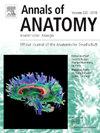How to deal with the variability of peripheral nerve lesion patterns after inguinal herniotomy? A descriptive approach for a new terminology in clinical practice
IF 2
3区 医学
Q2 ANATOMY & MORPHOLOGY
引用次数: 0
Abstract
Background
Inguinal hernia is one of the most common visceral surgical conditions in industrialised countries. The aim of the present observational clinical study was to investigate the dermatome patterns after nerve injury following inguinal hernia surgery and to demonstrate the marked individual anatomical and topographical variability of peripheral nerves in the inguinal region.
Methods
220 patients were followed up for one year after inguinal herniotomy. Surgical treatment was performed either with tension-free mesh techniques or open according (Lichtenstein).
Results
One year after inguinal herniotomy, 25 patients (11.4 %) reported postoperative symptoms. Of these, 15 patients showed evidence of a distinct nerve lesion. The results of the clinical neurological examination sometimes differed considerably from the subjective perceptions of the patients. In addition, a marked individual variability in the dermatomes of surgically lesioned nerves was found, with discrepancies to the classical and conventional dermatome data in textbooks.
Conclusions
This study has shown that it is hardly possible to assign a specific lesional inguinal dermatome to a specific nerve, as nerves show a large individual variability in their anatomical, topographical location and thus in their dermatome boundaries. Therefore, we propose a descriptive approach to the terminology of peripheral inguinal nerve lesions using common regional landmarks. This will avoid a potentially erroneous dermatome assignment to a certain nerve and facilitate the reproducibility of lesion descriptions between different observers, thus facilitating communication in clinical practice.
如何处理腹股沟疝气切除术后周围神经病变模式的可变性?临床实践中新术语的描述方法。
背景:腹股沟疝是工业化国家最常见的内脏外科疾病之一。本临床观察研究的目的是调查腹股沟疝手术后神经损伤后的皮膜形态,并证明腹股沟区周围神经在解剖学和地形学上存在明显的个体差异。方法:对 220 名腹股沟疝气切除术后一年的患者进行随访,手术治疗采用无张力网技术或开放式(Lichtenstein):结果:腹股沟疝气切除术一年后,25 名患者(11.4%)出现术后症状。其中,15 名患者有明显的神经损伤迹象。临床神经检查的结果有时与患者的主观感觉相差很大。此外,还发现手术病变神经的皮节存在明显的个体差异,与教科书中经典和传统的皮节数据存在差异:本研究表明,很难将特定的腹股沟病变皮节归属于特定的神经,因为神经在解剖学和地形学位置上存在很大的个体差异,因此其皮节边界也存在很大的个体差异。因此,我们建议采用一种描述性的方法,利用常见的区域地标来命名腹股沟周围神经病变。这将避免对某一神经进行可能错误的皮测分配,并提高不同观察者之间病变描述的可重复性,从而促进临床实践中的交流。
本文章由计算机程序翻译,如有差异,请以英文原文为准。
求助全文
约1分钟内获得全文
求助全文
来源期刊

Annals of Anatomy-Anatomischer Anzeiger
医学-解剖学与形态学
CiteScore
4.40
自引率
22.70%
发文量
137
审稿时长
33 days
期刊介绍:
Annals of Anatomy publish peer reviewed original articles as well as brief review articles. The journal is open to original papers covering a link between anatomy and areas such as
•molecular biology,
•cell biology
•reproductive biology
•immunobiology
•developmental biology, neurobiology
•embryology as well as
•neuroanatomy
•neuroimmunology
•clinical anatomy
•comparative anatomy
•modern imaging techniques
•evolution, and especially also
•aging
 求助内容:
求助内容: 应助结果提醒方式:
应助结果提醒方式:


